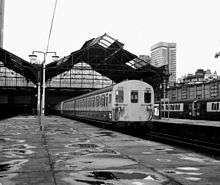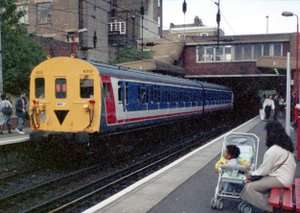British Rail Class 416
| British Rail Class 416 | |
|---|---|
|
Class 416/3 train in Network SouthEast livery calls at Dalston Kingsland Station, on a North London Line working. The NLL is both 25 kV overhead AC and 750 V third-rail DC electrified at this point. | |
| In service | 1955-1995 |
| Manufacturer | Ashford Works, Eastleigh works & Lancing works[1] |
| Number built | 128 |
| Formation | DMBS-DTS or DMBS-DTC |
| Operator(s) | British Rail |
| Specifications | |
| Car length | 19.50 m (63 ft 11 3⁄4 in) [1] |
| Maximum speed | 75 mph (121 km/h)) |
| Weight | DMBS 40 long tons (41 t)[2] DTS 30 long tons (30 t)[2] DTC 30 long tons (30 t)[3] |
| Traction motors | Two |
| Power output |
2 x 250 hp (190 kW) total 500 hp (370 kW) |
| Electric system(s) | 660-750 V DC third rail |
| Track gauge | 4 ft 8 1⁄2 in (1,435 mm) standard gauge |
British Rail Class 416 (2 EPB) electric multiple units were built between 1953 and 1956. They were intended for inner suburban passenger services on London's Southern Electric network. There were two subclasses of Class 416: Class 416/1 to an SR design on salvaged 2 NOL underframes, and Class 416/2 to BR's Mark I coach design.
With the introduction of yellow warning panels from late 1963 the motor coaches of all Southern Region 2 and 3-car units were equipped with an inverted black triangle in order to provide an early visual indication to station staff that there was no brake van at the other end of the unit. As units such the 4 EPB stock had a brake van at each end of the unit they were not so equipped.
In the 1980s some 2 EPB units were used on the North London Line between Richmond and North Woolwich; these units being equipped with window bars.
Tyneside units
Fifteen units built in 1954/5 to the BR Mark I coach design were built for the third rail electrified Tyneside Electric lines.
They were built at Eastleigh, and were the last Tyneside third rail EMUs built. They followed the new British Railways standard design for suburban rolling stock: similar units were built at the same time for use on South London suburban routes, but the Tyneside units had features in keeping with previous Tyneside EMUs, such as a large brake van to accommodate a large volume of fish boxes and prams; electric headcode lights on the cab front between the windows; and above those a roller destination blind. Unlike units of this style built for service in the south, the Tyneside units had a single first class compartment.
The units operated the South Tyneside services between Newcastle Central and South Shields, a route that had a busy commuter frequency and passenger numbers to match. British Railways decided to withdraw electric traction from these routes and the South Tyneside route was the first to be replaced by diesel units, being de-electrified in 1963. All 15 units were re-allocated to South London, Kent, Surrey and Berkshire, which entailed some rebuilding of the cabs and the declassification of the first class compartment. The units continued in passenger service until 1985 when they were all withdrawn.
A number of units survived for a few years longer on non-passenger duties as test or tractor units. One was used for testing the Tonbridge - Hastings line electrification before the route was opened for electric trains in the summer of 1986 by British Rail. This unit also carried out similar work on the East Grinstead electrification two years later and saw occasional use on other test and tractor duties until laid up in 1995, by which time it was the only South Tyneside unit left. It was purchased for preservation by SERA and was moved to Robertsbridge in Sussex for initial restoration work, and moved to the Electric Railway Museum, Warwickshire in 1999.
The work of the association in restoring the unit back to its 'as built' condition is both costly and time-consuming but is being progressed by a dedicated team of SERA volunteers. It is hoped to bring the unit on a return visit to the North East when the restoration is completed. This unique survivor is a treasured example of a bygone age of suburban rail travel in the North East.
Rebuilds
The 416/1 subclass (5651-5684) was rebuilt at Eastleigh Works in 1959 using underframes from withdrawn SR Class 2NOL units. The rebuilt units were initially classified 2 NOP but later absorbed into the 2 EPB classification. They had SR-designed bodies, similar to those of the earlier SR-design 4 SUB units and Bulleid locomotive-hauled coaching stock.
Electrical equipment
Each motor car had two 250 horsepower English Electric EE507 traction motors.
.jpg)

Numbering
Unit numbers
- Class 416/1 Rebuilds, 5651-5684 (These units were refurbished from 1983 and were reclassified 416/3 with units numbered 6301 - 6334)
- Class 416/2 Standard BR MK 1-TYPE stock, 5701-5779 (subsequently renumbered 6202 - 6279 from 1983), and the former Tyneside units, 5781 - 5795 (later 6281 - 6295; these units were withdrawn in 1985).
- Class 416/4. Created from 1986 after some units were refurbished. These were numbered 6401 - 6426.
Car numbers
- Tyneside stock:
- Motor cars, E65311-E65325
- Trailer cars, E77100-E77114
Preservation
The final units were withdrawn in 1995. Five units have been preserved, including an ex-Tyneside unit.
| Unit number (current in bold) |
DMBSO | DTSso | Built | Livery | Location | ||
|---|---|---|---|---|---|---|---|
| 5667 | 6307 | - | 14573 | 16117 | 1959 Eastleigh | BR(S) Malachite Green | Electric Railway Museum, Warwickshire[2] |
| 5759 | 6259 | - | 65373 | 77558 | 1956 Eastleigh | BR Green | In Storage at a private site in London |
| 5791 | 6291 | 932053 | 65321 | - | 1955 Eastleigh | Green primer / Blue grey | Electric Railway Museum, Warwickshire[3] |
| 5793 | 6293 | - | 77112 | ||||
| 5703 | 6203 | 930032/930204 | 65302 | - | 1955 Eastleigh | BR Green | Finmere railway station[4] |
| 5705 | 6205 | 930032/930205 | 65304 | - | 1955 Eastleigh | BR Green | Finmere railway station[5] |
| 5765 | 6265 | 930034/930206 | 65379 | - | 1955 Eastleigh | BR Green | Finmere railway station[6] |
| 5768 | 6268 | 930034/930206 | 65382 | - | 1955 Eastleigh | BR Green | Finmere railway station[7] |
Modelling
Bachmann Industries has released an 00 gauge model of a BR-design 2 EPB (416/2) in late 2011, in several liveries.
References
| Wikimedia Commons has media related to British Rail Class 416. |
- 1 2 Glasspool, David. "Class 415/416: 2/4 EPB". Retrieved 2008-02-16.
- 1 2 3 SERA. "Suburban Electric Railway Association - 2-EPB Units". Retrieved 2008-02-16.
- 1 2 SERA. "Suburban Electric Railway Association - South Tyneside 2 EPB EMUs". Retrieved 2008-02-16.
- ↑ http://www.cs.vintagecarriagestrust.org/se/CarriageInfo.asp?Ref=5932
- ↑ http://www.cs.vintagecarriagestrust.org/se/CarriageInfo.asp?Ref=5932
- ↑ http://www.cs.vintagecarriagestrust.org/se/CarriageInfo.asp?Ref=5934
- ↑ http://www.cs.vintagecarriagestrust.org/se/CarriageInfo.asp?Ref=5934
